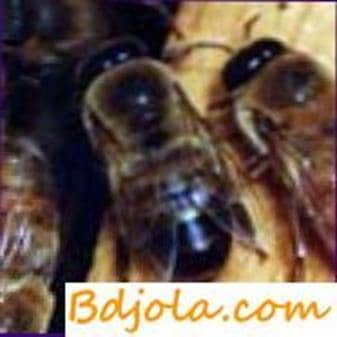
Pademic toxicosis is an infectious disease that occurs as a result of intoxication of bees and larvae by a pad.
Causes of the disease. Bees and their larvae perish under the influence of poisoning with a pad or honey. In case of toxic toxemia, the death of bees is less noticeable in the summer when the pad is collected and clearly expressed in winter with the maintenance of families on honey.
Pad is a sweet, sticky liquid. Distinguish the animal and plant padi. A drop of animal origin is given by aphids, chervets, mole-like leaf blocks, etc. A plant-derived fall is often called honeydew, which is a selection of plant juices accumulating on leaves or needles of trees. Vegetative fall is less dangerous for bees.
A drop of animal origin appears by the middle of the day on the leaves of trees in the sun. Rains and cold weather delay the development of aphids and the excretion of the padi. Rains wash the leaves of plants from aphids and padi.
Dry warm weather is a favorable condition for the development of aphids. It can be established in spring, summer and autumn. Therefore, the pad can be excreted by descendants at any time throughout the vegetative period. On plants in the garden often develop various microorganisms, which can enhance its toxic properties.
Many woody coniferous trees (spruce, pine, fir) and deciduous plants (willow, poplar, elm, maple, aspen, ash, mountain ash, linden, birch, bird-cherry, oak, chestnut, Amur lilac, velvet) stand out.
The most toxic to the bees is the fall of the last five species of trees. Poison toxicity depends on the presence of non-digestible carbohydrates (melizitose, mannose, lactose, esculin), alkaloids, glucosides, saponins, tannins, mineral salts and toxins released by microorganisms.
Course of the disease. In summer during the gathering of the fall, primarily flying bees fall ill, which die within 2-3 days and later. Bee-wet-nurses and larvae can also be ill, in which the pademic toxicosis develops somewhat later. In winter, the disease proceeds slowly, more often in the second half of winter and is accompanied by diarrhea.
Symptoms of the disease. Pademic toxicosis is accompanied by a strong digestive disorder followed by a mass death of bees. In the summer, the larvae may die at the age of 3-5 days. Patients in the summer can be found crawling on the ground, on the hive site, their abdomen increased. In winter, an unpleasant putrefactive odor is felt from the hives of patients with pademic toxicosis of families. Upon examination, the honeycombs, the walls of the hive, and the brown-dark spot are found on the honeycombs-the stool of the bees. At the bottom of the hive and near the flyers, many corpses of bees accumulate. The middle gut of the sick, not yet dead bees flabby, tears when trying to extract it from the abdomen. The color of the intestine is dark brown, black or bluish-dark.
In the nests of sick families, there is padome honey, which is determined roughly organoleptically according to dark brown or coffee color, without aromatic odor, less sweet taste and unpleasant metallic taste.
The diagnosis is based on the characteristic clinical signs, pathological changes in the mid-gut of bees and research. The medicine for the maintenance of pade substances. It is also necessary to exclude other diseases or environmental influences harmful for bees. Falling honey, located in the honeycomb, in the conditions of the apiary can often be determined by appearance and taste. When looking through a honeycomb through the passing light of the sun, the flower honey has a light yellow color, and the pad is allocated as dark-brown islands. There are honeycomb, entirely filled with dark brown honey. Dark color (excluding buckwheat and some other dark floral honey) is one of the essential signs of poor quality honey for bees.
It tastes benign honey of a fragrant “honey” smell, indicating its origin from certain plant species: from lime, meadow flowers, buckwheat, etc. Flower honey in the mouth quickly melts, easily mingles with saliva. In honeydew honey aromaticity and severity of a smell are absent or almost absent. Its taste rather resembles the taste of treacle, or cheap caramel, or gum of fruit and stone fruit trees, it keeps in the mouth for a while, it mixes poorly with saliva, is less sweet and has a higher viscosity.
It happens that the honey is not only dark. So, padovy honey from a tamnik in appearance transparent, like a linden, to taste a little bit sour, partly astringent. Decay honey is determined by chemical reactions.
Prevention. They create conditions that preclude the possibility of bees entering the nests by bees. For this purpose, honey plants are planted in the reserve areas so that they blossom at a time when there is no bribe in a given area, or bees are exported for the period of the appearance of a padi from the forest zone to the steppe with a copious bribe. When it appears in the nests of honey, honey is removed; do not allow the bees to winter on honey, replacing it partially (3-8 kg) with sugar syrup.
Control measures. Families who fall ill in summer are fed 1-1.5 liters of 50% sugar syrup, and families affected by the winter are given floral honey or refined sugar, slightly moistened with water. In the winter hut, the temperature is lowered to -1 њ, an over-exhibition of families is held for a purification flight, transplanted to new compressed nests, provided with benign food and insulated.
Good results are given by an early exhibition of bee colonies from winter premises. The exhibition is organized on a warm, windless, sunny day. At the same time, a cursory examination is carried out and, if necessary, assisted.
Вычинка шкур. Первый осмотр пчел весной.
Diseases of bees